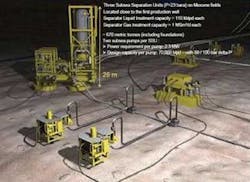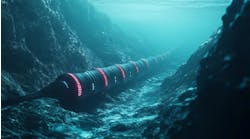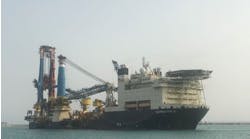Luc Riviere - Total E&P
Pazflor in block 17 offshore Angola constitutes a new technological step in the deep sea development adventure.
The Pazflor subsea gas/liquid (G/L) separation concept allows production of fields not specifically suited for subsea production (viscous and heavy oil, low productivity index, low gas oil ratios, etc.) and certainly will change the development perspectives in many areas of the world.
Pazflor is a world first for full-scale development based on subsea G/L separation and liquid boosting at the mud line.
Previous projects such as Troll, Tordis, and Marimba have demonstrated the feasibility of various subsea separation concepts. On these projects, however, only a limited number of wells are concerned.
On Pazflor, stakes are more as Miocene fields (which represent about 66% of the total reserves and production) rely on subsea G/L separation. In case of shut down or degraded performance of the system, the entire production of the associated line will be affected.
This clearly shows the criticality of the system, as well as its specificity as the main focus in the course of Pazflor concept selection, and robustness clearly tops the agenda.
Pazflor will benefit from the existing projects both from a technical and operational point of view, but will go a step further and represent a world first for the following:
- 1) Two-phase separation and liquid boosting at the mud line
- 2) Scale of the development
- 3) Hybrid pumps technology
- 4) Vertical separator technology.
Studies into possible development scenarios led to selection of subsea G/L separation with single production lines as the development concept for the Miocene fields. Following a cost estimation, the recommendation for basic engineering passed Total’s internal validation process and also secured approval from the block 17 partners StatoilHydro, ExxonMobil, and BP Sonangol, the Angolan national oil company, also was involved in the decision making.
Benefits for Pazflor
Subsea G/L separation provides advantages to produce heavy crudes from low energy reservoirs as long as the oil and field layout characteristics are favorable.
The main reasons to implement subsea separation on Pazflor Miocene fields are as follows:
- The activation system (separator + pumps) provides the additional energy required to sustain the Upper Miocene production profile, which would be less efficient with gas lift injected at the riser base
- Liquids and gas leaving the separator are produced away from the hydrate formation region, even during a shutdown. The preservation of the multiphase part of the system, i.e. upstream the separator, is performed by depressurization to avoid the need for a pigging loop
- The crude is not waxy so no regular pigging is necessary
- All flowlines slope down towards the FPSO, meaning they naturally empty into the separator during a shutdown; this also favors the restart operations (during cold restart, the system can be maintained at a reasonably low pressure, away from hydrate zone).
The main cost savings of subsea separation on Pazflor are:
- On the flowlines, umbilicals, and risers: With subsea production and water injection wells which “tee” into infield flowlines and flow into a seabed separation unit. This means reduced flowline length, no manifolds, fewer spool pieces, no pigging loops, reduced insulation requirements on the flowline due to less stringent cooldown requirements and lower methanol demand, additional in line tees (ILT) with ROV operated valves, reduced number of risers: 1 x 10 in. + 2 x 6 in. instead of 2 x 10 in. + 2 x 4 in. for gas-lift.
- On subsea production systems: With the installation of three subsea separation units (SSU), with related umbilical and topside equipment.
- On drilling: With an overall reduction in drilling trajectory length, because wells are “teed” into flowlines, additional flexibility for reservoir in terms of well targets implantation.
Cost savings on the FPSO include the following:
- With a reduced compression size (no more gas-lift)
- Suppression of dead oil circulation (pump + heaters)
- Reduction of size of the first stage separator (no requirement for a slug catcher)
- An overall efficiency of the artificial lifting mean, leading to reduced power generation (compared with BRGL + MPPs).
On operations, money is saved with an easier preservation sequence, and smoother stabilized production (with more stabilized flow in the risers, slug catching is not required).
Subsea G/L separation qualification
Due to Miocene heavy and viscous oil (heavier and more viscous than Dalia), the main focus of the pre-award qualification was put on G/L separation efficiency and technical solution for the subsea pumps.
The G/L separation efficiency was investigated during the course of Pazflor pre-project studies through:
- 1. Tests with viscous synthetic oil in transparent downscaled units, under atmospheric pressure. This was run at Cranfield University, UK, and aimed to choose the separator configuration (horizontal versus vertical) and to test different internals.
- 2. Tests with real Miocene crude (Dalia oil added with Sincor oil to increase the viscosity) and gas, in a downscaled unit, under pressure, in the selected vertical separator. This was run at IFP (Institut Français du Pétrole) to confirm GVF (gas volume fraction) figures were acceptable for Pazflor subsea pumps design. Both steps explored extremely high viscosities (up to 2,500-3,000 cP), representing the real crude behavior during a cold restart at 4° C (39° F), as well as various flow rates, operating pressures, and inlet piping arrangements.
- 3. Tests with Pazflor Miocene crude will be the ultimate test to validate the concept before installation.
Based on test results, two pump vendors developed “hybrid” pumps, consisting of a combination of helico-axial and centrifugal stages for one vendor, and a centrifugal pump with modified first stage impellers for the other.
The two pumps went through qualification to define their gas handling capacity under viscous flow, as well as the viscosity handling capacity. Pump tests were successful for both contractors (eventually testing the limits of the function under very severe conditions). The first concept was chosen.
Pazflor SSU – Miocene fields (artistic view). (Courtesy of Techniques Effects). The figures indicated are estimates established in the basic engineering phase. They will be specified in the detailed engineering phase.
Solids handling also is addressed, as the separator will be installed on the seabed at 800 m (2,625 ft) water depth for 20 years and not be retrieved under normal operations.
The philosophy has been to avoid sand accumulation in any part of the system, by installing a vertical separator and a conical shape at separator bottom.
In case of massive sand production (such as sand screen failure) leading to cone clogging, provision has been taken for an ROV connection to a jetting ring. There also are various possibilities of fluidizing a sand plug, such as back-flushing from the liquid risers back to the separator.
Studies confirm that sand cannot accumulate in any piping part. Tordis already pushed the pump technology in this domain and Pazflor takes advantage of that.
Solids management within the separator and its internals is being designed and qualified in the detailed engineering phase.
A number of verification tests have been performed to confirm the performances of the separation and pumping selected concepts.
A full-scale hybrid pump (a combination of two helico-axial impellers and six centrifugal ones) was fabricated during 1Q 2008 to Pazflor’s requirements, and was tested from May to mid-June 2008.
The results validate the concept (but with fewer impellers) and confirm the operating envelope of the pump in full compliance with Pazflor requirements.
The manufacturing of the series of eight hybrid pumps (six pumps to equip a total of three subsea separation and pumping stations plus two spare pumps) subsequently was launched.
While the vertical separator concept was selected during the pre-project phase, a qualification program was launched as part of the project execution for selecting the internals of the separators. Screening studies and dynamic simulations were performed to select the base case internals (inlet, evenflow, spiral, bottom cone). A smaller separator with internals then was built to test for separation performance as well as sand tolerance. The tests were run successfully from June to July 2008, allowing the selection of the optimum internals design for Pazflor.
Subsea layout/architecture
Pazflor processes two different oils, thus leading to two different subsea schemes:
1. “Conventional” flow loop with manifolds on Oligocene
Preservation is based on live oil displacement with stabilized oil. Reservoir pressure is maintained by combined water and gas injection: water in most of Oligocene horizons, and gas in Oligocene upper sands. One main common umbilical serves the production wells by manifold distribution system and flying leads, and the injection wells by dedicated injection umbilicals.
2. Subsea G/L separation and liquid boosting pumps on Miocene (world first)
Production wells are “teed” individually or by pair on a single production flowline, connected to the separator of the subsea separation unit (SSU). Then liquids are boosted by two pumps to the FPSO. Gas flows naturally to surface.
There is one SSU per Miocene production line. Miocene fields are developed with three lines. The SSUs are near the first production well for a quick heat-up during a cold restart.
There is one main common umbilical per production line, serving the production wells by flying leads, and the injection wells by dedicated injection umbilicals. Each SSU has its own power and control umbilical.
Preservation of the multiphase line against hydrates is done by depressurization after the “no touch time” of four hours. The entire subsea network is depressurized from christmas tree choke to the separator via the gas lines of the SSU. The liquid line of the SSU naturally is outside the hydrates formation zone, since most of the light ends have been flashed off; no preservation against hydrates is performed on it.
On Miocene reservoirs, pressure is maintained by water injection only. Each production line is associated with its injection line.
On both Miocene and Oligocene production wells, a multiphase flow meter is installed for production allocation purpose. Each production well is equipped with a sand detector.
Acknowledgements
TOTAL E&P Angola expresses its gratitude to Sociedade Nacional de Combustíveis de Angola (SONANGOL), StatoilHydro, Esso Exploration Angola (Block 17) Ltd., BP Exploration (Angola) Ltd., for their support to develop Pazflor.





